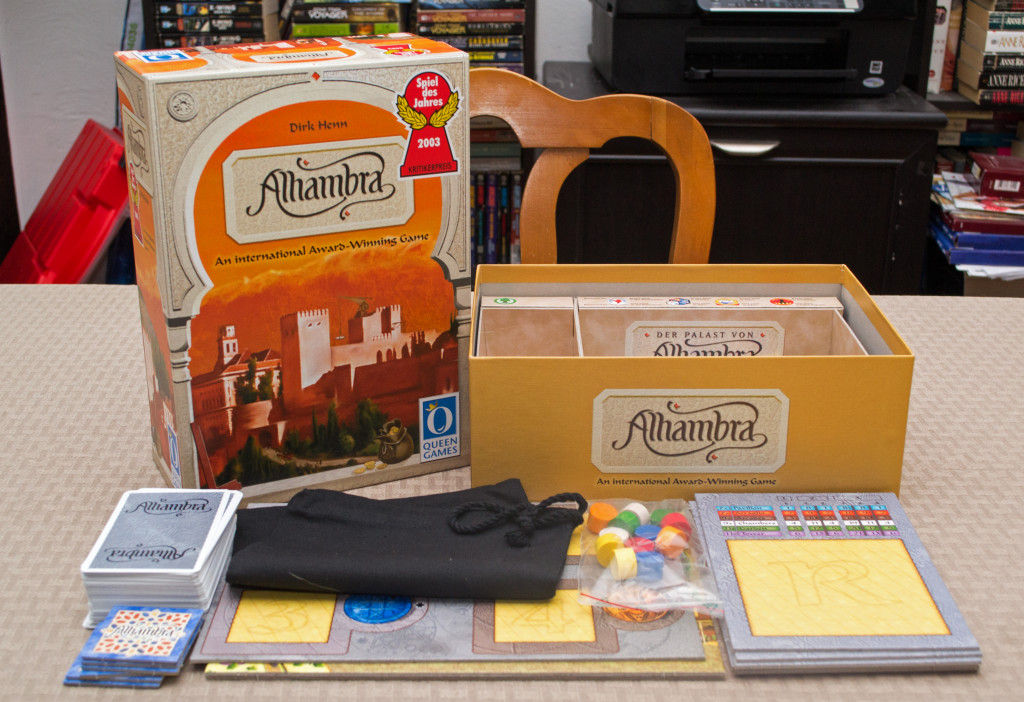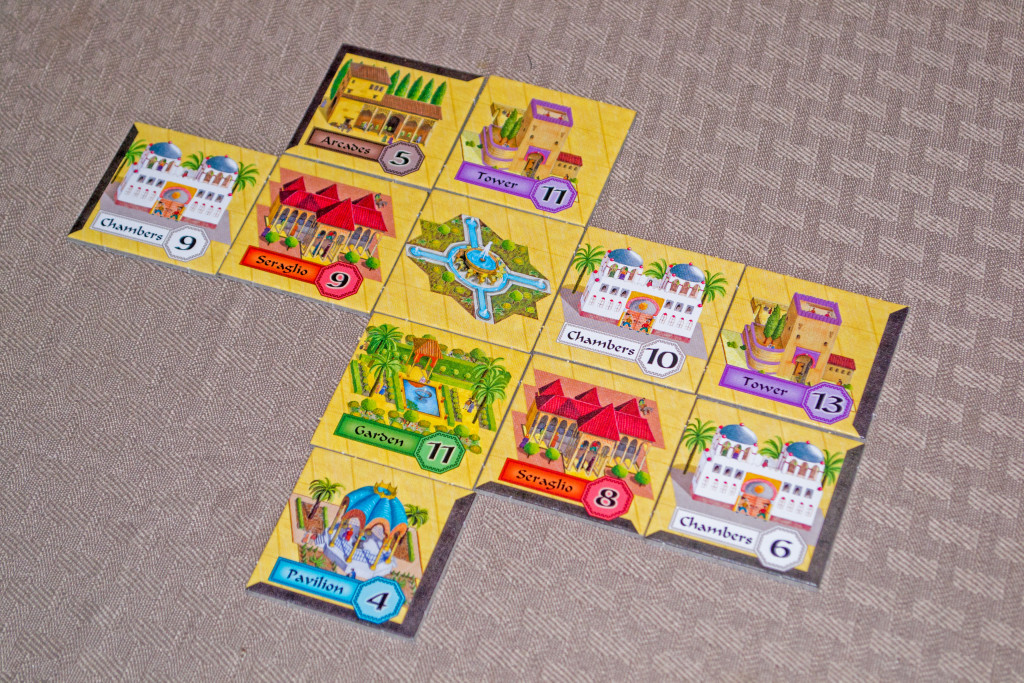Alhambra: “Palace of the Moorish monarchs of Granada, Spain, built (1238–1358) on a plateau above the city” (Merriam Webster). Sounds exciting, right? Well, it just may very well be for those of you puzzle geeks who love to build stuff. “Alhambra” will task players with buying & placing various building tiles, though there’s a catch: each builder you hire wants paid in their native currency. Don’t worry, this mechanic doesn’t turn the game into an exchange rate nightmare from hell as getting this money is easier than it sounds. Still, I suppose I should explain it all a bit more and let you be the judge.
Components
6 Starting Tiles, 54 Building Tiles, 1 Building Market, 1 Scoring Board, 12 Counters, 108 Money Cards (four colors/currencies), 2 Scoring Cards, 6 Tile Reserve Boards, 1 Bag
Setup & Gameplay
Each player receives a starting tile, which they place in front of them. Players choose a color and receive a set of their counters along with a tile reserve board/points table. One counter will be placed on top of their starting tile, while another is placed on the bottom left corner of the scoreboard to track individual scores. The building market is placed in the center of the table while the scoring board is placed off to the side for reference purposes. The 54 building tiles are placed into the bag, with four being randomly drawn and put onto the four numbered squares of the building market. In addition to players receiving money cards (via a process I won’t get into here), four more money cards are laid face-up on the market. The two score cards are seeded appropriately in the money deck. The player with the least money cards goes first.
A player can take one of three actions on their turn:
1. Take Money – A player can take any number of money cards (the currencies don’t matter) so as long as they do not add up to more than 5. The exception is if you take a single card, in which case the value can be anything.
2. Buying & Positioning Building Tiles – A player can spend money to buy a tile from the market and place it either into their Alhambra or into their reserve (some tile placement rules apply). If a player buys the tile using exact change, they may take another free action. If a player overpays, no change is given. Replacement tiles are not drawn until the turn is over, so at most a player can que up five actions on one turn (buying four tiles with exact change and doing something else).
3. Redesign – A player can either take a building from their reserve and place it into their Alhambra, remove a building from their Alhambra and place it into their reserve, or exchange one tile for another from both places.
At the end of the turn, new tiles/money cards are drawn to replace any that may have been purchased/taken, respectively.
There are three scoring rounds. The first two are triggered when the scoring card comes up in the money deck. Players earn points for whoever has the most of each building color, as well as points for their longest joined wall on the outside of their Alhambras. The end of the game (final scoring round) is triggered when there are not enough tiles in the bag to bring the market up to four tiles again. Scoring is done the same way as the other two rounds and whoever has the highest grand total, wins!
Editor’s Note: The above doesn’t cover all of the rules found in the manual, but should give you an idea as to how the game is played.
The Review
“Alhambra” isn’t what I would call a competitive game and this could be good or bad, depending on what personalities comprise your group. I say this because throughout the entire game, you are essentially playing against yourself. You control your own Alhambra at all times with no way to directly attack or effect someone else’s. It’s like each player has their own puzzle, though the pieces of which are “bought” from a central pool that is constantly changing. I’m personally fine with how the game plays out because the kids can sometimes be overly competitive. Here, I don’t have to worry about that.
There’s also a two player variant involving “Dirk” (an imaginary third person that players will be competing against). He doesn’t have his own Alhambra, but does collect tiles in a particular way and scores points appropriately. While recommended for balancing issues, I personally find it viable to do away with Dirk in a two player game and just play via the standard rules. Along those lines, the less people you have playing, the more you can plan based on what’s in the market. Things get a bit chaotic with four or more players and you’ll thus be reduced to making a decision based on that moment in time, a reality that some may find to be unappealing.
As such, “Alhambra” will be hit or miss for some folks. Those who are competitive and enjoy screwing people over in an “in-your-face” kind of way may not enjoy this title. On the other hand, those who enjoy the comfort of working on their own puzzle with the caveat of very little player interaction will feel right at home. Just be warned that the more players you add, the more downtime you’ll have and the less strategic things will get (due to the market constantly changing before your next turn). I personally enjoyed “Alhambra” and found it very easy to pick up and play…worth a buy if you have the money and fit the recommended gamer profile.
Final Verdict: 7/10
—


